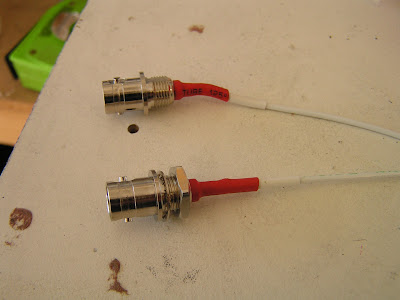Now that the hard part is over, I still stand by my words...sealing the tanks is NOT that bad. I still have to do the end ribs and the baffle, but I should be able to use my pneumatic squeezer on those so that should be a snap. I will say, having your riveting skills down pat and the gun set up properly helps alleviate stress as well. I only had to drill out one rivet during this process and that was huge.
Let me just say, the only way I can boast that it isnt that bad is the fact that I have leveraged all of the great knowledge and tips from builders who have gone before me. Without that, it probably would be a bitch...that makes all the difference. Builders nowadays have a wealth of experience at their fingertips to be more efficient. And for that, I am thankful.
This is the process I used and it worked good for me.
1. Have the tank cleco-ed together and ready to go before mixing your ProSeal.
2. Respirator on, remove a rib...scotchbrite mating surfaces, blow off debris with air hose, clean with MEK
3. Use your gun to apply ProSeal to the skin
4. Cleco the rib back in place
5. Move to the next rib and repeat
6. Get them all ProSealed and cleco-ed in place before switching to the rivet gun
7. This is where I deviated a little...I now removed my respirator and did all of my riveting. I am not recommending this...just saying this is what I did and had good results. The ProSeal is actuall pretty benign, didnt bother me at all. To be able to remove that mask made things much more enjoyable for me
I used most of the tube contents on this task and it took me about 2 1/2 hrs from start to finish. Kind of like a fire drill...I kept a good pace, worked with purpose, but also didnt rush or be frantic. The working time for a batch of ProSeal is supposed to be 90 mins max I think so I really stretched it. At the end of that time, it was starting to set up pretty good so I would say that was just about a maximum for my shop temp and humidity. This was a pretty amibitious work session...I've read about a lot of builders doing one or two ribs at a time.
After the task was complete, I spent about an hour cleaning up...removing ProSeal from cleco's, tools and work area. Thats kind of a pain and I did put the respirator back on for this since I was using MEK again.
Hardly anyone takes any pics while doing ProSeal since no one wants to gunk up their camera. I dont blame them...but my process was so neat I actually took a couple. So here is one (not very clear) showing how I did my ProSeal before installing the rib. I didnt do the whole mating surface as I think that is overkill...I just paid attention to the actual rivet holes. Make sure to completely encircle the holes and get some in the actual hole itself so it will ooze out a little bit. That way, if you do it properly, you wont need to add ProSeal to the rivet or exterior hole. There will be enough to fully envelop the factory head when you set the rivet. Below is a shot of my gun/tube.



















































